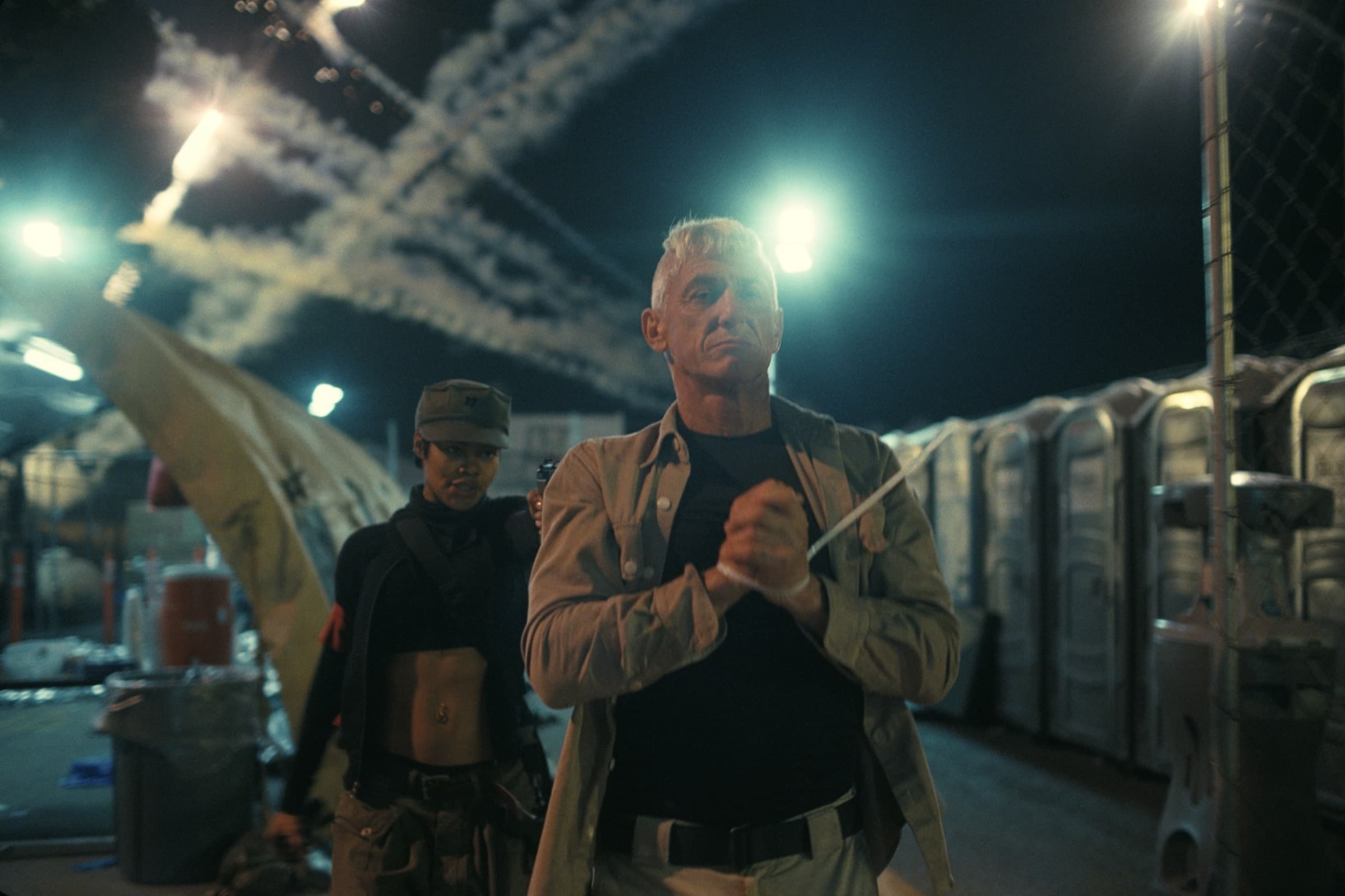Text within this block will maintain its original spacing when published
Reviewed: One Battle After Another (film, Paul Thomas Anderson, 2025) Eddington (film, Ari Aster, 2025) Your Party (debacle, Jeremy Corbyn and Zarah Sultana, 2025) Zack Polanski (leader of the Green Party, Philip and Ava Paulden, 1982) No Kings; Gaza solidarity (protest movements, the egregore, 2023-5) The left (ordinal direction, urbilaterian organism, ~555,000,000 BC) The present (moment, the past, now)Lately I’ve been trying to work out exactly how long I’ve been living in the Kingdom of Soissons.
The Kingdom of Soissons was not actually a kingdom, but by the time the smoke cleared everyone had already forgotten any other name for a group of people living together under common laws. The world was drawn in thicker lines now. Kings and subjects, heroes and feuds. What we know is that some time around 460 AD, a Roman aristocrat called Aegidius was appointed as magister militum per Gallias or commander of the legions in Gaul. This was not such a great post. Ten years earlier the province had been burst open by Attila and his Huns; now little Germanic kingdoms were wriggling around in the wound, sometimes nominally under Roman authority, sometimes fighting the Empire, sometimes fighting each other. Shortly afterwards the emperor who’d given Aegidius his post was deposed and assassinated by his magister militum in Italy. There were a few more emperors after that, little flickering nonentities like Olybrius and Glycerius, before the whole sad charade was wrapped up for good. In its place there was now something called the Kingdom of Italy, which was ruled by a man called Odoacer who was probably a Goth but maybe a Hun or possibly some kind of Turk. Beyond the Alps there were more barbarian kingdoms: the Burgundians, the Alemani, the Rugii. But in a distant swathe of what’s now northern France, from Nantes to Reims and the Loire to the Somme, Aegidius still held his post, governing the last province of an empire that no longer existed.
It lasted ten years. Not such a short time. One fiftieth the lifespan of the entire empire. Long enough to live in. Long enough for people to meet and marry and have children, and raise them in a world where Romanitas still held. I imagine that life in Soissons was dominated by a kind of eerie calm. People playing dress-up, dressing up as themselves. Pretending the old world was still there, while heretics and idol-worshipping pagans massed on the borders. It could have held out longer. The Kingdom of Soissons was large, bigger than any of its barbarian neighbours. Its lands were fertile and well-watered. It was governed under a Roman bureaucracy, which was vastly more efficient than the spoils-sharing systems that surrounded it. It had the benefits of a thousand years of literacy and civilisation. But none of that mattered. Either history is on your side or it isn’t, and they could only hold out against history for so long.
Ten years after the fall of the Western Roman Empire, an idol-worshipping pagan called Hlodowig tore through the Roman armies at Soissons, destroyed the last Roman province in the West, and set up his own kingdom in the ruins. (We’re not even certain that Soissons was the administrative centre of the state; it’s just named after the battle in which it ended.) Aegidius might have thought he was preserving Roman civilisation from the end of the world, but whatever it is that rules history, God or Geist, had other plans. Twenty-two years after the Battle of Soissons, Hlodowig converted to Nicene Christianity. You might know him as Clovis I, King of the Franks. Three hundred years later, his successor Charlemagne would go to Rome, where Pope Leo III put a crown on his head and declared him Roman Emperor. In the end it wasn’t Soissons that inherited the old world, but the people that destroyed it.
There are Kingdoms of Soissons everywhere, things that have outlived themselves but keep limping on. Marriages: sometimes a couple will go to northern France for their honeymoon and never really leave, slogging through decade after loveless decade in grey Soissons, both fully aware that the thing has been over for a very long time, but still mysteriously unwilling to disengage. There’s still a Blockbuster Video in Bend, Oregon. You can still go to Kmart in Guam. Dutch tourists keep crowding the Camden High Street, even though there’s nothing there any more except keychain shops and coffee chains. If you still care even slightly about the fate of the literary novel in an age of screen-swiping imbeciles, you are, like me, a citizen of Soissons.
Thomas Pynchon’s Vineland is set in the Kingdom of Soissons. It’s 1984, the year of Reagan’s re-election, sixteen years since the radical counterculture of the 1960s reached its climax and started to ebb away. All the radicals and revolutionaries are addicted to weed or TV now, living in the city of Vineland, a sanctuary for washed-up hippies where they can peacefully moulder away as the world around them grows plastic and cruel. ‘Dismantle the New Deal, reverse the effects of World War II, restore fascism at home and around the world.’ There’s the same sense in Inherent Vice. ‘At every gathering—concert, peace rally, love-in, be-in, and freak-in, here, up north, back east, wherever—those dark crews had been busy all along, reclaiming the music, the resistance to power, the sexual desire from epic to everyday, all they could sweep up, for the ancient forces of greed and fear.’ There was a beautiful moment when we might have been ruled by something other than greed and fear, but it’s gone. The best you can do is huddle in its wreckage.
Paul Thomas Anderson’s One Battle After Another, which is loosely based on Vineland, is also set in the Kingdom of Soissons. This time it’s the present. And we do seem to be in a repeat of the 1980s, another era of reactionary retrenchment. If anything, it’s worse. Things are bad out there. The plump, soft, rosy-cheeked boys who staff for mainstream Republican politicians don’t even read Bronze Age Mindset any more, they just chortle away at Twitter accounts that post the words total nigger death over and over again. This is normal now. State policy is informed by a kitchen cabinet of anime-watching paedophiles. Twelve-year-old kids are self-identifying as incels. Their only dreams for the future are to have eight hundred thousand dollars a year, the ugliest Miami apartment imaginable, and some kind of racial holocaust. No one can make eye contact any more. It’s getting bad.
And the film is a good image of this present, spookily good. The bulk of the story is about a military unit that invades the small Californian town of Baktan Cross, rounding up its population of druggies and migrants. This takes place so its commander can join a society of mawkish milkdrinkers called the Christmas Adventurers Club. This was filmed in early 2024, before the last US election, the accompanying vibe shift, the ICE goons unleashed on major American cities to conduct mass kidnap operations and fatly roll tear gas canisters at anyone who frowned at them on the street. But the images are exactly the same. This shouldn’t be surprising. For all the noise and spectacle of Trump’s immigration raids, he’s actually deported people at a substantially lower rate than either Obama or Biden. The noise and spectacle is the point, though; it’s all just grievance and revenge, making your enemies feel terror, acting out a theatre of terror on the streets of Chicago and LA, to be consumed in sixty-second increments by the Twitter-maddened base. One Battle After Another is not an image that pre-emptied reality; Paul Thomas Anderson and Donald Trump are both great American artists with a deep instinct for the swirling content of their country’s id, and they both happened to land on the same scene.
Where I think the film stumbles is in its representation of the left. The real reason the soldiers are in Baktan Cross is to find a sixteen-year-old girl, who lives with her paranoid, addled father in a hideout in the woods. He’s a former revolutionary; he and the girl’s mother once belonged to an underground group called the French 75. But she was arrested after a bank robbery that went wrong, and gave up the rest of the group; now they’re all either dead or in hiding, and he’s reduced to rambling half-remembered Howard Zinn material to his daughter’s history teacher. It’s easy to sympathetically portray a burned-out former revolutionary. We’re all living in the wreckage of what we wanted to be when we were younger. Failure is relatable; it makes audiences feel seen. But what failure are we even talking about here?
In the film’s prologue, set sixteen years before the main story, we get to see the French 75 in their prime. Attacking military bases, robbing banks, putting bombs in courthouses, all leather jackets and Afros and carbines. If One Battle After Another is set in the present day—and from the iPhones it seems to be—then the revolutionary prologue would have to take in the year 2009. I remember 2009. The closest thing we had to a revolutionary black underground that year was when Barack Obama invited Henry Louis Gates for an awkward beer in the White House. All the stuff we see in the film is 60s shit. It really did happen, but not recently; we’re about as far away from the Black Panthers as they were from the reign of Queen Victoria. The difference between One Battle After Another and Vineland is that One Battle is set in a post-revolutionary stupor without any actual revolutionary period preceding it. The last time the radical left was ascendant, leftist radicals weren’t bombing courthouses. They were trying to get a food writer fired for culturally appropriating the chickpea.
.png)



